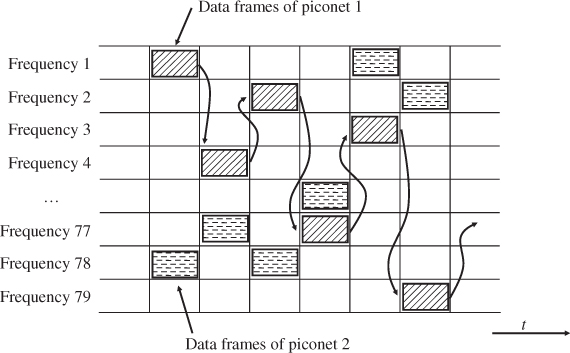7.3 Piconets and the Master/Slave Concept
As previously described, all devices that communicate with each other for a certain time form a piconet. As shown in Figure 7.2, the frequency hopping sequence of the channel is calculated from the hardware address of the first device that initiates a connection to another device and thus creates a new temporary piconet. Therefore, devices can communicate with each other in different piconets in the same area without disturbing each other.
Figure 7.2 By using different hopping sequences, many piconets can coexist in the same area.

A piconet consists of one master device that establishes the connection and up to seven slave devices. This seems to be a small number at first. However, as most Bluetooth applications only require point-to-point connections as described in Section 7.1, this limit is sufficient for most applications. Even if Bluetooth is used with a PC to connect with a keyboard and a mouse, there are still five more devices that can join the PC's piconet at any time.
Each device can be a master or a slave of a piconet. Per definition, the device that initiates a new piconet becomes the master device as described in the following scenario.
Consider a user who has a Bluetooth-enabled mobile phone and headset. After initial pairing (see Section 7.5.1), the two devices can establish contact with each other at any time and thus form ...
Get From GSM to LTE: An Introduction to Mobile Networks and Mobile Broadband now with the O’Reilly learning platform.
O’Reilly members experience books, live events, courses curated by job role, and more from O’Reilly and nearly 200 top publishers.

